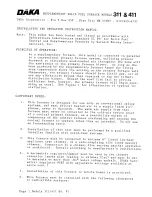
035-14370-000
650.75-N4U
Unitary Products Group
21
j.
De-icing salts or chemicals
k.
Carbon tetrachloride
l.
Halogen type refrigerants
m. Cleaning solvents (such as perchloroethylene)
n.
Printing inks, paint removers, varnishes, etc.
o.
Hydrochloric acids
p.
Cements and glues
q.
Antistatic fabric softeners for clothes dryers
r.
Masonry acid washing chemicals
VENT PIPE SIZING (1-PIPE SYSTEM)
Refer to Table 7 to select the proper size piping for venting.
The size will be determined by a combination of furnace
model, total length of run, and the number of elbows required.
The following rules must also be observed.
NOTE:Furnace vent pipe connections are sized for 2-in. pipe.
Any pipe size change must be made outside the furnace cas-
ing in a vertical pipe section to allow proper drainage of vent
connections.
NOTE:An offset using two 45 degree elbows may be required
for plenum clearance when the vent is increased to 3".
1.
Long radius elbows are required for all units.
2.
Elbows are assumed to be 90 degrees. Two 45 degree
elbows count as one 90 degree elbow.
3.
One Vent terminal elbow is already accounted for and
should not be counted in the allowable total indicated in
the table. See “VENT TERMINAL LOCATION
CLEARANCES" Section on page 21 . This part is shown
shaded.
4.
All vent pipe and fittings must conform to American
National Standards Institute (ANSI) standards and Amer-
ican Society for Testing and Materials (ASTM) standards
D1785 (Schedule 40 PVC), D2665 (PVC-DWV), F891
(PVC-DWV Cellular Core), D2241 (SDR-21 and SDR-26
PVC), D2261 (ABS-DWV), or F628 (Schedule 40 ABS.
Pipe cement and primer must conform to ASTM Stan-
dards D2564 (PVC) or D2235 (ABS).
5.
The use of flexible connectors or no hub connectors in
the vent system is not allowed.:
VENT TERMINATION (1-PIPE SYSTEM)
Side wall horizontal vent terminals and roof mounted vertical
terminals may be field fabricated. Standard PVC/SRD fittings
may be used. Terminal configuration must comply as detailed
in this section.
When selecting the locations for vent termination, the follow-
ing should be considered:
1.
Comply with all clearance requirements. (Refer to Figure
25 on page 22)
2.
Termination should be positioned where vent vapors will
not damage plants or shrubs or air conditioning equip-
ment.
3.
Termination should be located where it will not be
affected by wind gusts, light snow, airborne leaves or
allow recirculation of flue gases.
4.
Termination should be located where it will not be dam-
aged or exposed to flying stones, balls, etc.
5.
Termination should be positioned where vent vapors are
not objectionable.
VENT TERMINAL LOCATION CLEARANCES
The vent must be installed with the following minimum clear-
ances(Refer to Figure 25 on page 22), and complying with
local codes or utility requirements or other authority having
jurisdiction.
1.
1 foot above grade and above normal snow levels.
2.
Not above any walkway.
3.
4 feet below, 4 feet horizontally from, or 1 foot above any
door/window or gravity air inlet to the building, or from
gas or electric meters.
TABLE 7: VENT PIPING / 1-PIPE SYSTEM (ALL
MODELS)
Model
Pipe Size
Max. Elbows vs. One Way Vent
Length (Ft.)
5-40
45
50
75
All Models Except:
120 / 112 / 2000 / D
140 / 130 / 2000 / D
2”
6
5
4
N/A
All Models Except:
120 / 112 / 2000 / D
140 / 130 / 2000 / D
3”
8
7
6
5
120 / 112 / 2000 / D
140 / 130 / 2000 / D
3” Only
6
5
4
N/A
In Canada, refer to CAN/CGA-B149.1 or.2 Installation
Code (latest edition - Venting Systems and Air Supply)
















































